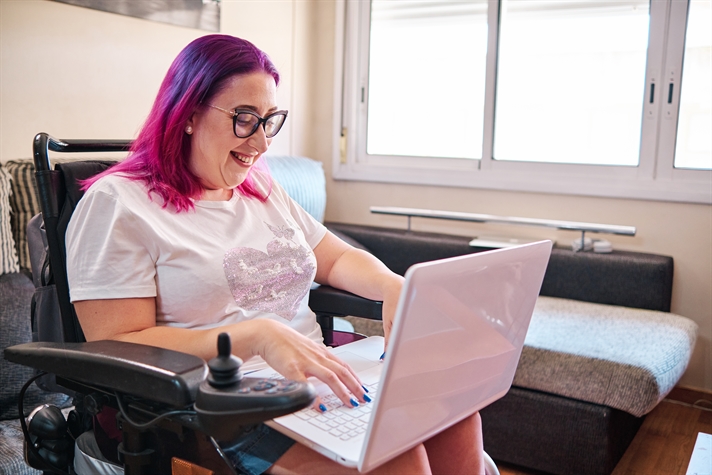Accessibility should be a concern for all organisations, but especially if you are running a charity or other not for profit organisation. Accessibility can help you reach a wider audience and be more inclusive to everyone who might need your help. Here are a few top reasons this could benefit your charity and society at large.
1 You can increase the size of your audience
In the UK, 1 in 4 people are disabled [1] , and almost a third of households contain at least one disabled person. Web accessibility can affect a wide range of conditions, including some that are not generally considered disabilities, such as colour blindness. Here are some stats on groups in the UK that can benefit from web accessibility.
- 5 million people have a learning disability [2]
- 3 million people have dyslexia [3]
- 2 million people are living with sight loss [4]
- 12 million have hearing loss above 25dBHL [5]
- 3 million people are affected by colour blindness [6]
On top of this there are other accessibility issues it can be harder to calculate, for example, the range of people who can’t use a computer mouse effectively, such as users with arthritis, MS, Parkinson’s, peripheral neuropathy, limb loss and a range of other conditions.
And don’t forget to factor in the extra benefits to non-disabled users too. Just as subtitles on TV are often used by non-disabled people, the same can be true online. For instance, captions on videos, or text transcripts of a video’s content, can be handy if you are in a crowded office or on a busy train and don’t have your headphones.
Increasing the size of text or zooming in can be useful if you are further from the screen, eg if you are showing something on a projector at a meeting, or viewing a website via your TV. And making sure you don’t embed text as part of an image can allow Google to translate that text to other languages, making your site easier to use for non-English speakers.
In addition to this, some accessibility fixes can help make your site more responsive, so it is easier to use for customers looking at the site on a mobile phone.
More visitors can lead to more donations
The online spending power of people with access needs is around £274 billion per year [7] to UK business.
It could be easy to think that disabled users might persevere with your website even if it doesn’t work quite right for them, but that would be a mistake. Organisations often lose money when disabled visitors leave their inaccessible websites. 7 in 10 disabled customers [8] say they will click away from a website they find difficult to use. In 2019, the estimated loss from the ‘Click-Away Pound’ was £17.1 billion [9] . Organisations that priorities digital inclusion have 28% higher revenue [10] .
2 It’s the law
For a private business owner, the law makes it clear that you have to make ‘reasonable adjustments’ to make sure your services are accessible to people with disabilities, under The Equality Act 2010 . It’s also not enough to wait until a disabled person makes a complaint about your website to start thinking about accessibility. According to the UK Equality and Human Rights Commission (EHRC) any organisation that provides a service online has an ‘anticipatory’ duty to make reasonable adjustments. Any disabled website visitor who feels they have been discriminated against by a company online can make a claim in court
Public sector organisations
All public sector organisations, which includes government departments, NHS organisations, colleges and universities and some charities, are subject to extra laws, in addition to the ones mentioned above.
The Public Sector Bodies (Website and Mobile Applications) (No. 2) Accessibility Regulations 2018 (PSBRA) states that any public sector website offering a service must meet the Web Content Accessibility Guidelines (WCAG) level AA. These rules can be enforced by the EHRC.
3 It’s the right thing to do
It’s not easy to be a disabled person in a world that hasn’t been built for you. While for an able person, the difficulties faced by disabled people might only be noticeable now and again, for a disabled person trying to get through the day, you face constant barriers both big and small, and they all add up.
According to Scope, 49% of working age adults feel excluded from society because of their condition or impairment, and 41% working age disabled people do not feel valued by society.
While sometimes there can be substantial challenges to making a service accessible, such as trying to make an historical building accessible, the web is one place it could be very easy. And because the physical world is often much harder for disabled people to access, they have an even greater need of online services than able people do.
Despite this, disabled people are 50% more likely to face barriers accessing digital and online services compared to non-disabled people [11] , and accessibility errors are slowly going up [12] .
How to make your website more accessible
Getting an accessible website doesn’t have to cost more money - all you need is a digital agency that knows how to meet the guidelines, and to learn a few techniques yourself to make sure the content you add will work for disabled people too.
All the websites we create at Eonic Digital are built to the WCAG AA standards. We can meet the AAA standards on request, although this will dramatically restrict the palette colours available. We can also offer you help and advice on making sure the content you add to your website meets these rules too.
So for your next web project, why not choose a web agency that makes the needs of disabled users a priority? If you aren’t ready for a new website, or aren’t sure if you have an issue, here at Eonic Digital we offer a free review of your existing website, to let you know of any barriers your disabled users might face.
Please contact us on 01273 761 586 to find out more.
[1] https://business.scope.org.uk/accessibility-and-disability-facts-and-figures/
[2] https://www.mencap.org.uk/learning-disability-explained/research-and-statistics/how-common-learning-disability
[3] https://www.gov.uk/government/publications/understanding-disabilities-and-impairments-user-profiles/simone-dyslexic-user
[4] https://www.rnib.org.uk/professionals/health-social-care-education-professionals/knowledge-and-research-hub/key-information-and-statistics-on-sight-loss-in-the-uk/#:~:text=As%20of%202017%2C%20there%20are,176%2C125%20are%20registered%20sight%20impaired
[5] https://rnid.org.uk/get-involved/research-and-policy/facts-and-figures
[6] https://committees.parliament.uk/writtenevidence/3324/pdf/
[7] https://wearepurple.org.uk/the-purple-pound-infographic/
[8] https://wearepurple.org.uk/the-purple-pound-infographic/
[9] https://www.clickawaypound.com/
[10] https://business.scope.org.uk/accessibility-and-disability-facts-and-figures/
[11] https://business.scope.org.uk/article/accessibility-and-disability-facts-and-figures
[12] The WebAIM annual accessibility analysis of the top 1 million homepages


